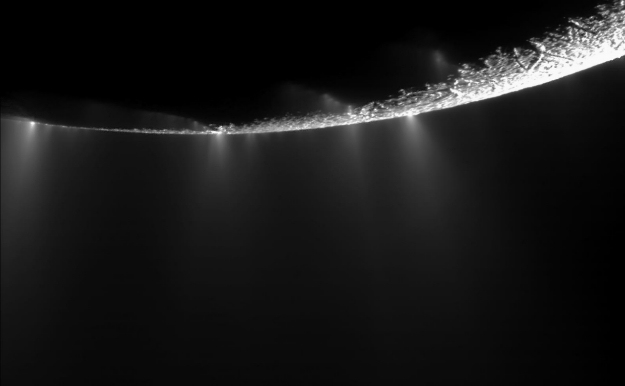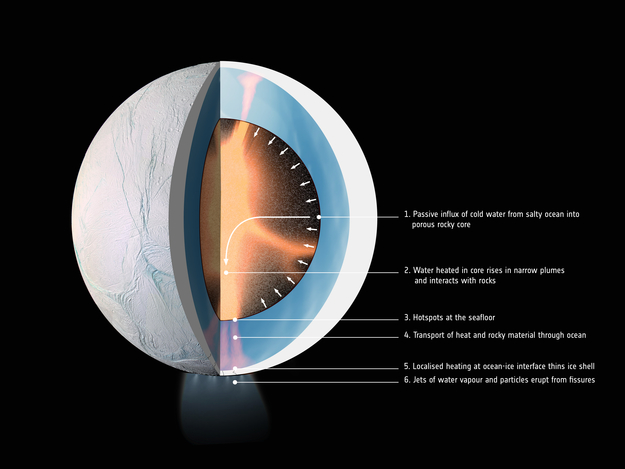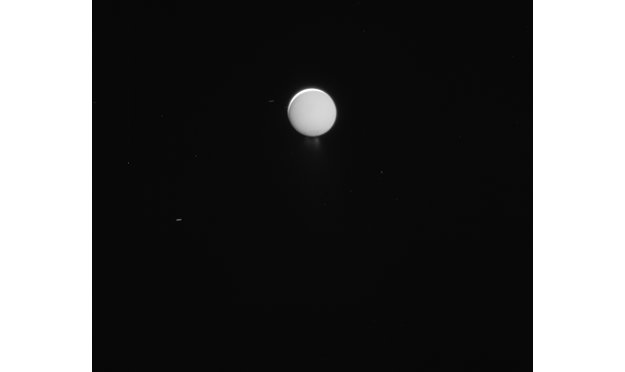Saturn Moon Enceladus' Churning Insides May Keep Its Ocean Warm

The mystery of why the ocean beneath the icy shell of Saturn's moon Enceladus did not freeze over long ago may now be solved — heat from the scraping of rock churning within the fragmented core of Enceladus could keep its underground ocean warm for up to billions of years, a new study finds.
This heat could help provide the kinds of conditions required for life to develop, according to the study.
In 2005, NASA's Cassini spacecraft discovered jets of water ice, organic molecules and other material blasting into space from giant fissures near Enceladus' south pole. Researchers suspect these jets come from an ocean "buried beneath a relatively thin ice shell 20 to 25 kilometers [12.4 to 15.5 miles] thick on average," said study lead author Gael Choblet, a planetary scientist at the University of Nantes in France. [Inside Enceladus, Icy Moon of Saturn (Infographic)]
Enceladus is only about 314 miles (505 kilometers) wide, making it small enough to fit inside the borders of the state of Arizona. Given its tiny size and thin icy crust, one might have expected it to have cooled off rapidly after its formation and frozen solid by now. Previous research suggested that in order for Enceladus to still possess an internal ocean, a giant heat source was required, one generating more than 20 billion watts, which is about as much power put out by the Three Gorges Dam in China, the largest power station on Earth.

One possible source of this power is tidal heating. Whereas tides on Earth are caused by the gravitational pull of the moon and sun, tidal forces on Enceladus are mostly caused by Saturn, and are strong enough to significantly flex and heat its ice and rock.
Prior work suggested that Saturn's tidal effects on the icy shell of Enceladus would generate a relatively weak amount of heat. Without added warmth, this ocean should have frozen solid within 30 million years.
Now, researchers suggest this ocean keeps warm because of Saturn's tidal effects on the core of Enceladus. The scientists detailed their findings online today (Nov. 6) in the journal Nature Astronomy.
Get the Space.com Newsletter
Breaking space news, the latest updates on rocket launches, skywatching events and more!
Previous research suggested Enceladus's core is made of fragmented rock. Choblet and his colleagues estimated that spaces packed with rock grains and water make up about 20 to 30 percent of the core.
"What we have in mind is not a sponge, where all the solid fragments are interconnected, but a pile of sand and gravel," Choblet told Space.com.
The scientists designed a computer model based on Cassini data that simulated the heat generated by tidal forces acting on Enceladus' porous core. They found the resulting friction between rock grains could generate more than 10 billion to 30 billion watts of heat.

The researchers added that heated water from the core could well outward and upward, generating hotspots on the floor of the buried ocean, particularly at the south pole of Enceladus. The new model can therefore explain the ocean of Enceladus as well as the activity seen at its south pole.
Choblet and his colleagues found this effect could heat Enceladus from tens of millions of years to billions of years. This may be long enough to supply the kinds of conditions needed for life to develop, they said.
Follow Charles Q. Choi on Twitter @cqchoi. Follow us @Spacedotcom, Facebook and Google+. Original article on Space.com.
Join our Space Forums to keep talking space on the latest missions, night sky and more! And if you have a news tip, correction or comment, let us know at: community@space.com.

Charles Q. Choi is a contributing writer for Space.com and Live Science. He covers all things human origins and astronomy as well as physics, animals and general science topics. Charles has a Master of Arts degree from the University of Missouri-Columbia, School of Journalism and a Bachelor of Arts degree from the University of South Florida. Charles has visited every continent on Earth, drinking rancid yak butter tea in Lhasa, snorkeling with sea lions in the Galapagos and even climbing an iceberg in Antarctica. Visit him at http://www.sciwriter.us









